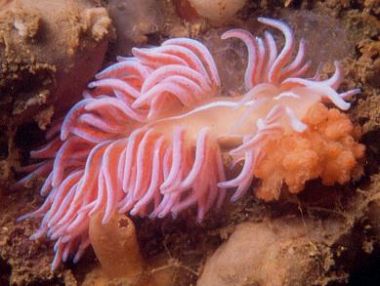
Phyllodesmium horridum
(Macnae, 1954)
Order: NUDIBRANCHIA
Suborder: AEOLIDINA
Family: Glaucidae
DISTRIBUTION
Southern tip of South Africa from Cape of Good Hope to Sodwana Bay.
PHOTO
Brazenhead, Eastern Cape, South Africa, 25m, July 2001. 40mm long. Photo: Valda Fraser.
Body translucent cream to orange, with viscera showing through. There is an opaque white median dorsal band, of irregular width, running along the back of the animal, and an opaque bluish-white band along the upper side of each ceras.
Some authors consider this South African species to be synonymous with Phyllodesmium serratum, which is known from Australia and Japan, but I have shown consistent differences (Rudman, 1991) which suggest they should be considered distinct species. The most distinctive external difference is the broad opalescent or opaque bluish-white dorsal band down each ceras in P. horridum which has no equivalent in P. serratum, and in P. horridum the denticles on the radular teeth are much coarser than in P. serratum.
Gosliner reports that this species feeds on the gorgonian Melitodes.
References:
• Rudman, W.B. (1981) The anatomy and biology of alcyonarian feeding aeolid opisthobranch molluscs and their development of symbiosis with zooxanthellae. Zoological Journal of the Linnean Society, 72: 219-262.
• Rudman, W.B. (1991) Further studies on the taxonomy and biology of the octocoral-feeding genus Phyllodesmium Ehrenberg, 1831 (Nudibranchia: Aeolidoidea). Journal of Molluscan Studies, 57(2): 167-203.
Rudman, W.B., 2001 (August 9) Phyllodesmium horridum (Macnae, 1954). [In] Sea Slug Forum. Australian Museum, Sydney. Available from http://www.seaslugforum.net/find/phylhorr
Related messages
Re: Phyllodesmium horridum -egg laying?
January 31, 2008
From: Georgina Jones
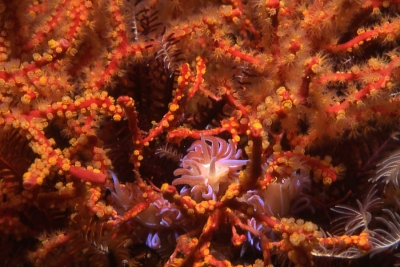
Concerning message #21310:
Dear Bill,
Well I can't say I like 'horridum' either, but as we say here, 'rules is rules'!
I attach a picture of said Phyllodesmium horridum on the fan Acabaria rubra -- I think feeding but am not sure.
Locality: False Bay, 24 m, Western Cape, South Africa, Indian Ocean, 2006, rocky reef. Length: 30 mm. Photographer: Sharon Albert.
Best wishes
Georgina
gjones@icon.co.za
Jones, G.I., 2008 (Jan 31) Re: Phyllodesmium horridum -egg laying?. [Message in] Sea Slug Forum. Australian Museum, Sydney. Available from http://www.seaslugforum.net/find/21317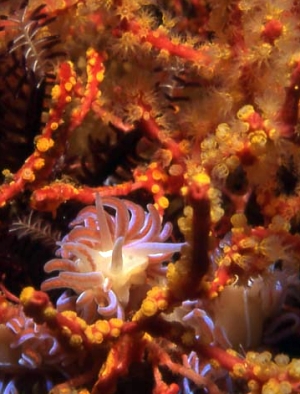
Thanks Georgina,
Bill Rudman
Re: Phyllodesmium horridum -egg laying?
December 15, 2007
From: Georgina Jones
Concerning message #21224:
Dear Bill,
Thank you for your reply.
The soft coral in question is the purple soft coral, Alcyonium fauri. It is known to be fed upon by one of our endemic Tritonias, and also possibly by Leminda millecra. We usually see Phyllodesmium horridum feeding on a gorgonian as stated by Gosliner, but the genus is Acabaria. I'd agree with you that it might have a more varied diet than we at first have thought.
Best wishes
Georgina
gjones@icon.co.za
Jones, G.I., 2007 (Dec 15) Re: Phyllodesmium horridum -egg laying?. [Message in] Sea Slug Forum. Australian Museum, Sydney. Available from http://www.seaslugforum.net/find/21310Dear Georgina,
Thanks for the information. if you get the chance to photograph any nudibranchs feeding on on their food it would be great if you could send photos to the Forum. Apart from encouraging others to do likewise, it is a valuable way of building up information, and sharing it, with the worldwide malacological community.
You may have wondered why I have changed your spelling from horridus to horridum. I know the species has usually been known as Phyllodesmium horridus but part of the International Rules insists that the species part of the name matches the gender of the genus part, so it has to be changed to Phyllodesmium horridum. I can't say I agree with this, but I try to be a law-abiding citizen.
Best wishes,
Bill Rudman
Phyllodesmium horridum -egg laying?
December 11, 2007
From: Georgina Jones
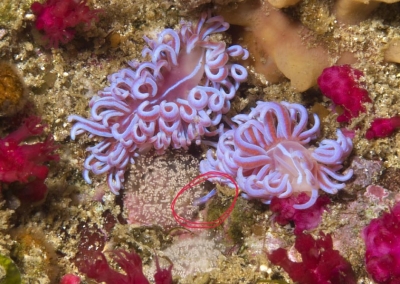
Dear Bill,
A friend of mine found a pair of Phyllodesmium horridum in a rock pool, one of which we think may be in the act of laying eggs -- would the eggs be laid from a sort of ovipositor as sown or is this just an artefact of the picture?
Locality: Smitswinkel Bay, 5 m, Western Cape, South Africa, False Bay, Indian Ocean, October 2007, rock pool low tide. Length: 4cm. Photographer: Geoff Spiby.
Regards
Georgina
gjones@icon.co.za
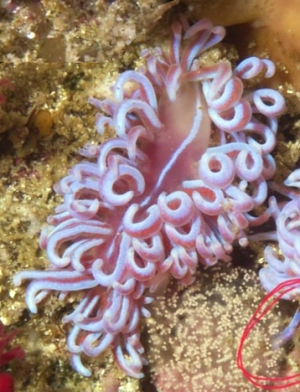
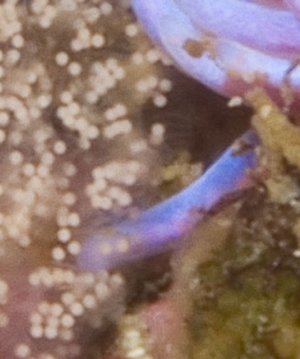
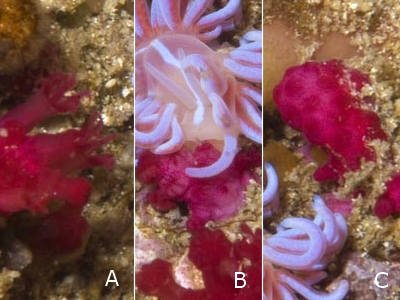
Dear Georgina,
The egg ribbon could possibly be that of Phyllodesmium but its a bit hard in your photos to see enough detail to know if it is a nudibranch egg ribbon or not. Concerning the possible ovipositor it is in fact the elongate tip of the tail - or more correctly the posterior tip of the foot. Some species of Phyllodesmium have quite an extended 'tail' like this which produces quite a sticky mucus. I presume for animals living in quite high current areas its a helpful way to stay attached to your food source. It is possible the tip of the foot is used in manipulating the egg ribbon as it is being deposited, but that presupposes that the eggs are the nudibranchs, and I can't be sure they are.
There is another interesting subject in your photo. Scattered around are small red patches of some cnidarian, presumably an octocoral of some sort. In the photomontage alongside, I show three parts of your photo in more detail. In A, softcoral animals [the polyps] are fully extended while in C, they are fully retracted. In the middle photo [B] I am pretty sure the nudibranch is feeding on the colony and the polyps are semi-retracted. You will see the red colour in the digestive gland ducts of the cerata matches the red of the soft coral very well.Gosliner reports that this species feeds on the gorgonian Melitodes. On first sight this doesn't look very gorgonian-like to me but I don't know anything about Sth African cnidarians. If anyone can identify the cnidarian in these photos it would be a useful contribution
Best wishes,
Bill Rudman
Phyllodesmium horridum from South Africa
August 11, 2001
From: Valda Fraser

Dear Bill,
I think this is Phyllodesmium serratum from the Eastern Cape. Could you please confirm its identity.
Locality: Brazenhead, Eastern Cape, SOUTH AFRICA, 25 m
Date: July 2001
Size: 40mm
Thanks,
Valda Fraser
valdafraser@mweb.co.za
Fraser, V., 2001 (Aug 11) Phyllodesmium horridum from South Africa. [Message in] Sea Slug Forum. Australian Museum, Sydney. Available from http://www.seaslugforum.net/find/4864Dear Valda,
After the Phyllodesmium photos you have sent me which I can't identify easily, it's nice to get a photo of Phyllodesmium horridum. It has previously been synonymised with Phyllodesmium serratum but as I discuss at the top of the page they are different species.
Best wishes,
Bill Rudman.
